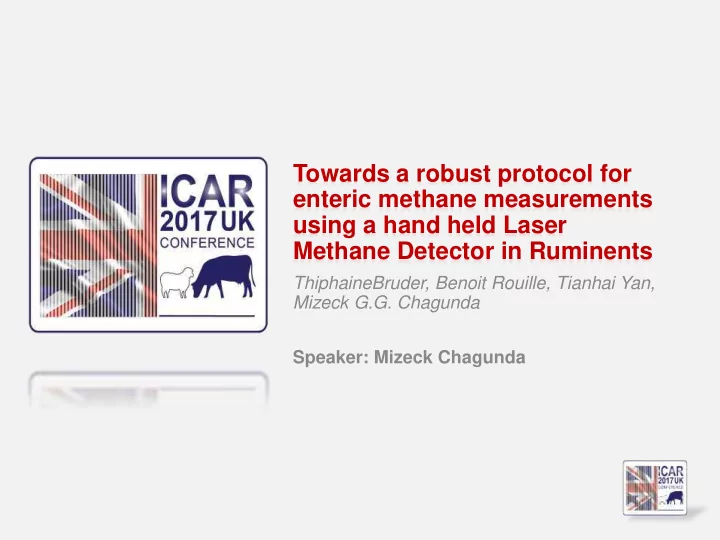

Towards a robust protocol for enteric methane measurements using a hand held Laser Methane Detector in Ruminents ThiphaineBruder, Benoit Rouille, Tianhai Yan, Mizeck G.G. Chagunda Speaker: Mizeck Chagunda
Laser Methane Detector in Dairy Cows Thiphaine Bruder, Benoit Rouille, Tianhai Yan, Mizeck Chagunda Leading the way in Agriculture and Rural Research, Education and Consulting
Why Methane? • Methane (CH 4 ) is produced as part of the normal digestive process in ruminants. • 89% of methane emitted from ruminants is produced in the rumen and exhaled through the mouth and nose • Formed in the rumen by methanogens (archaea, protozoa, fungi and bacteria) using hydrogen and CO 2
Traditional Methods • Respiration calorimetry chambers • Tracer Gas Techniques • Sniffer technologies • Micro Met Technique
Laser Methane Detector • Based on infrared absorption spectroscopy • Using a semiconductor laser as a collimated excitation source • Employs second harmonic detection of wavelength modulation spectroscopy to establish methane concentration
What we know so far?
Breath cycles 1600 Eructation Breath 1400 1200 1000 800 cow1953 600 400 200 0 0 100 200 300 400 500 600 700 1600 1400 1200 1000 cow1814 800 600 400 200 0 0 100 200 300 400 500 600
Correlation with the Chamber 160 1000.00 Dairy Cows Sheep 900.00 140 800.00 120 LMD Methane, ppm 700.00 100 600.00 80 500.00 400.00 60 300.00 40 200.00 20 100.00 0 0.00 5 50 500 Chamber Methane, log10 ppm 700 y = 0.6983x + 114.95 600 Metabolic Chamber (ppm) 500 • Sensitivity and specificity for cows were 400 95.4% and 96.5%. 300 200 • For sheep, sensitivity was 93.8% and specificity was 78.7%. 100 0 0 100 200 300 400 500 600 700 800 Laser Methane Detector (ppm)
New Questions • Which data do we extract? • When should we measure? • How long should we measure?
What data to extract? Processed Raw LMD Chamber Chamber LMD data data (ppm) methane (ppm) methane (g/day) (ppm) Min 0 24 12 85 Max 49287 237 177 170 Mean 125.3 114 84.7 127.8 Variance 294656.9 2020.0 519.3 240.2 SD 542.8 45 22.8 15.5 N = 44208 for LMD and 44208
Distribution of Raw LMD data
Distribution LMD after Outliers
Density Distribution Chamber
What data to extract? Processed Raw LMD Chamber Chamber LMD data data (ppm) methane (ppm) methane (g/day) (ppm) Min 0 24 12 85 Max 49287 237 177 170 Mean 125.3 114 84.7 127.8 Variance 294656.9 2020.0 519.3 240.2 SD 542.8 45 22.8 15.5 N = 44208 for LMD and 44208
When to measure? 0.7 0.6 0.5 0.4 r 0.3 0.2 0.1 0 Standing Lying and Lying Standing Lying and Standing Standing and moving Eating and Eating Ruminating and a lot Ruminating Activity 95% DataSet 99% DataSet
How long should we measure? • Measurement duration had a significant effect (p<0.01) on the concentration of methane measured by LMD • 60s measurements significantly low (p<0.001) • LMD measurement window of at least 3 minutes long, recommended
Relationship to g/day chamber methane 300 250 LaserWindow (ppm) 200 150 100 50 0 80 90 100 110 120 130 140 150 160 Chamber (g/day) R² = 0.42 and r = 0.65 𝐃𝐢𝐛𝐧𝐜𝐟𝐬𝐡𝐞𝐛𝐳 = 𝐌𝐛𝐭𝐟𝐬𝐗𝐣𝐨𝐞𝐩𝐱 + 𝟐𝟑𝟖. 𝟑𝟐 𝟑. 𝟏𝟏
Conclusion • LMD is a promising proxy for measuring enteric methane • Need to understand the data • Build on what we know to develop a robust protocol for measuring enteric methane using LMD.
…thank you for your attention
Relationship to conc.(ppm) chamber methane
Recommend
More recommend